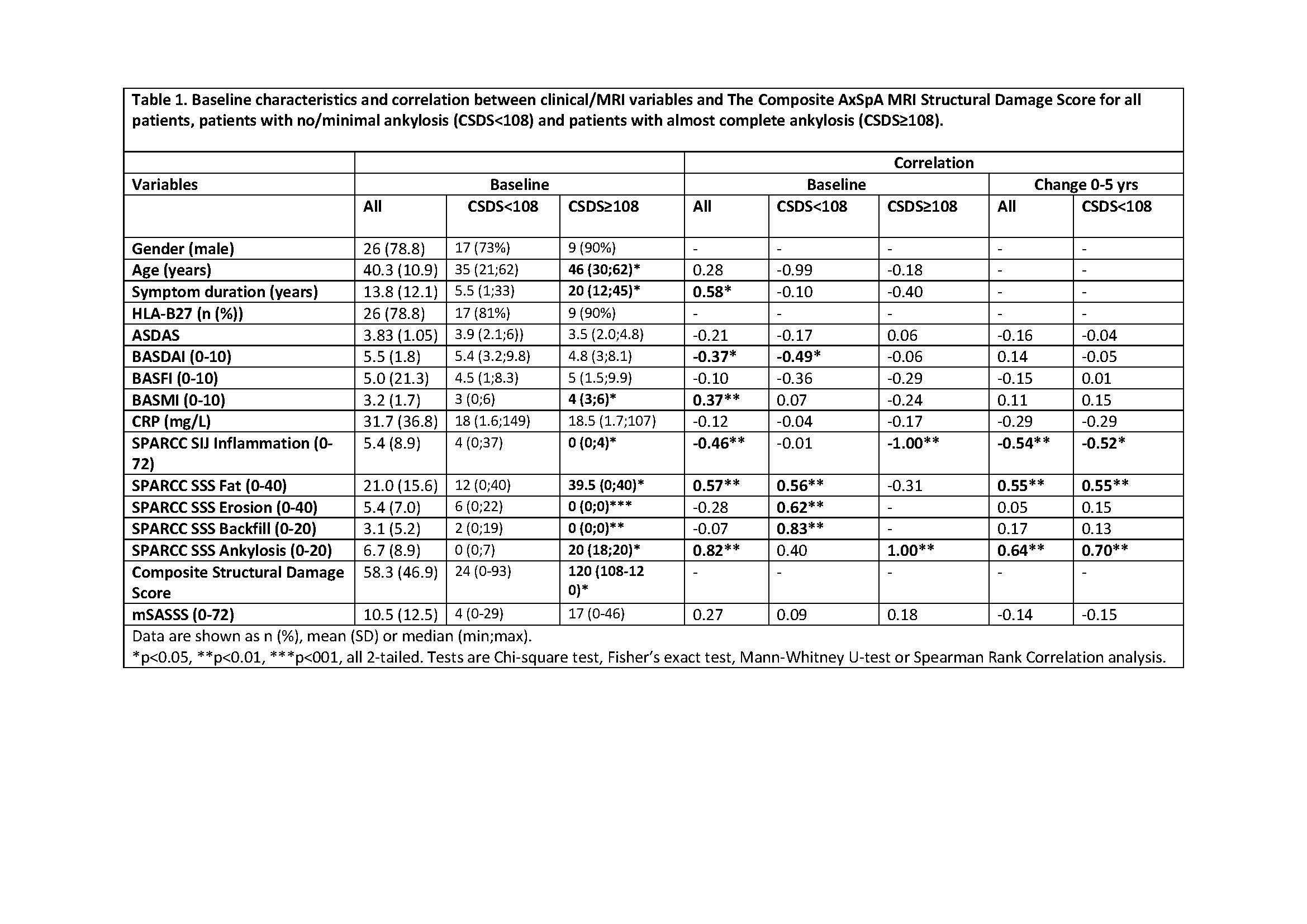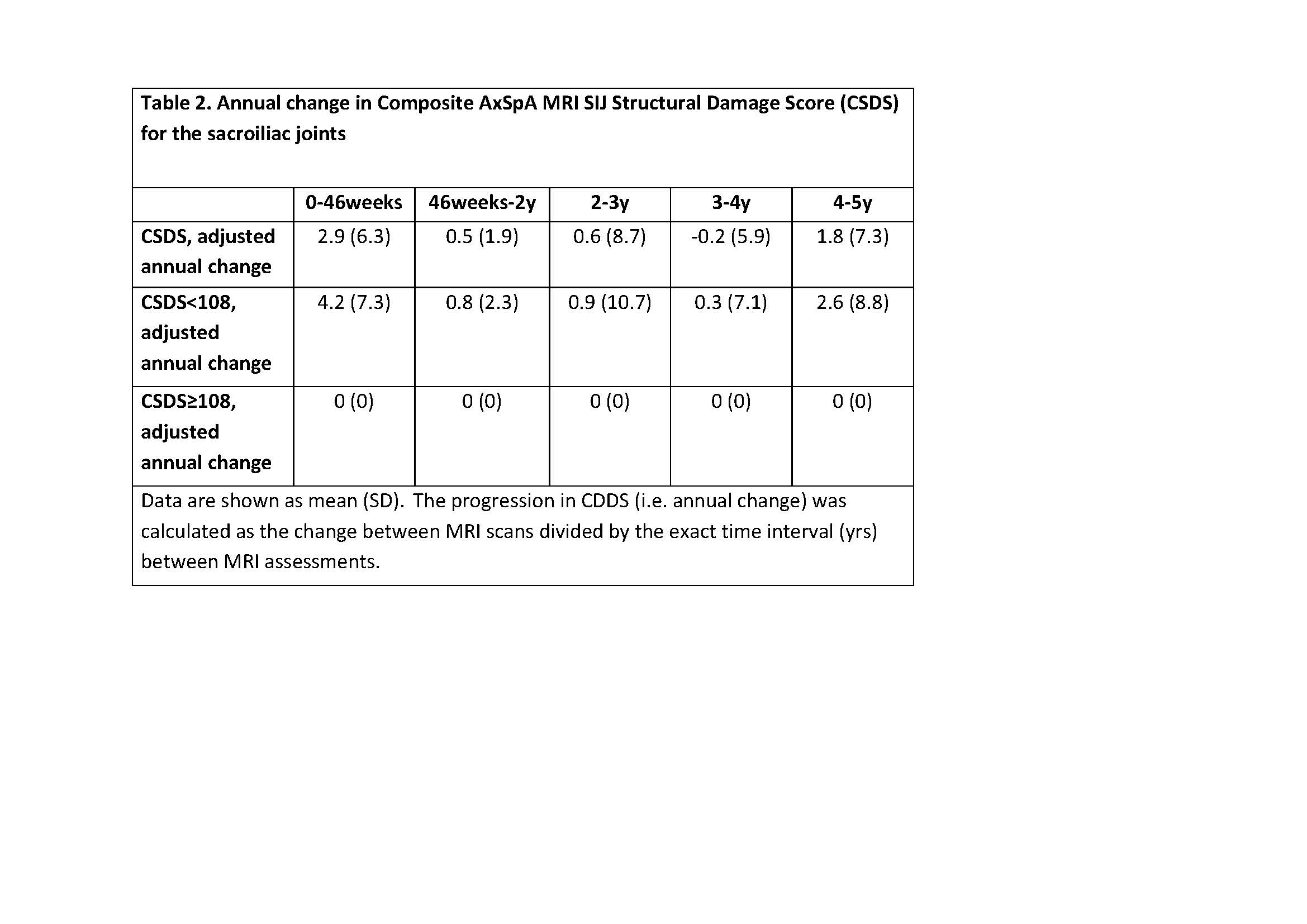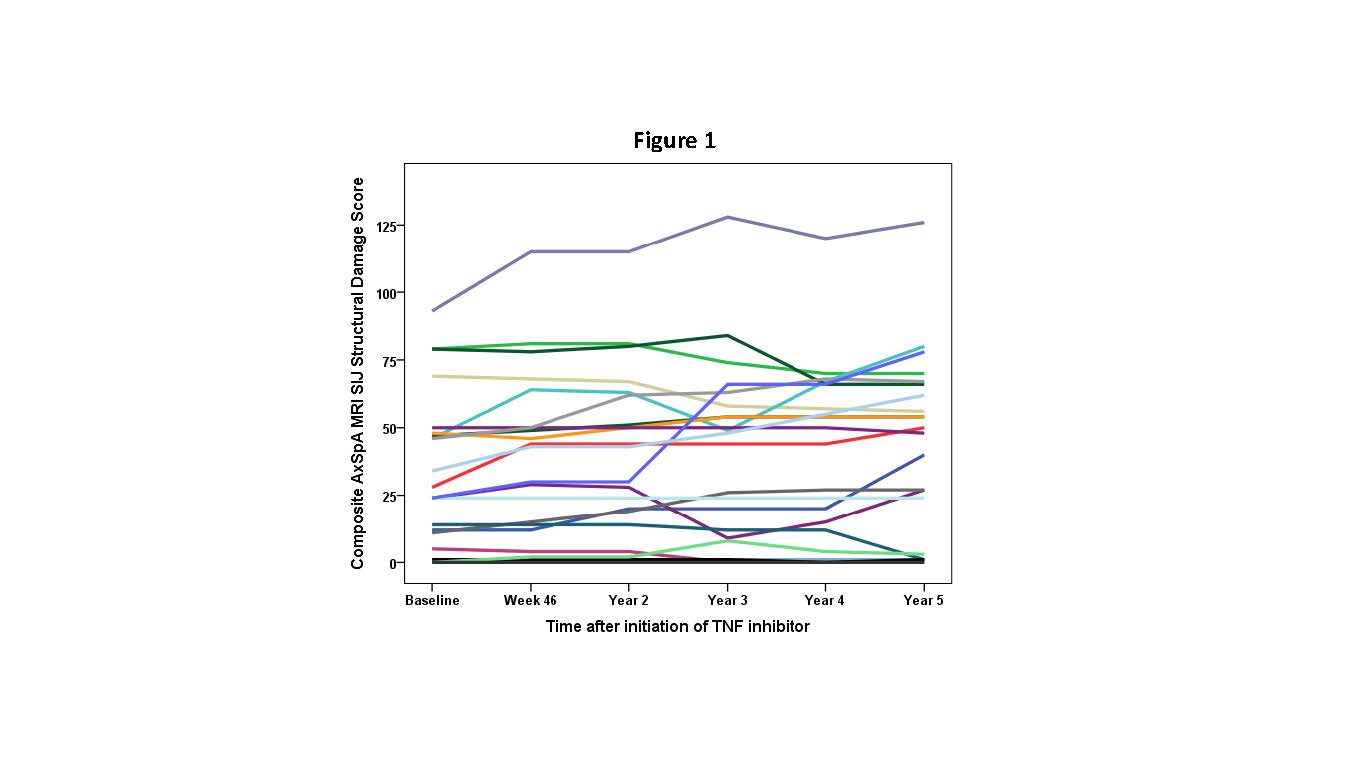Session Information
Session Type: Poster Session (Monday)
Session Time: 9:00AM-11:00AM
Background/Purpose: In patients with axial spondyloarthritis (axSpA), MRI reliably detects structural lesions in the sacroiliac joints (SIJs). The SPARCC Sacroiliac joint (SIJ) Structural Score (SSS)(1) is a reliable and validated method to assess the individual structural lesions of the SIJs, i.e. fat lesion, erosion, backfill (fat metaplasia in an erosion cavity) and ankylosis. Several MRI studies have indicated that bone destruction, i.e. erosion, is often followed by formation of new bone in the erosion cavity (backfill), ultimately leading to ankylosis(2). The aim was to combine these lesions into a composite score for SIJ structural damage and to test it in a 5-year follow up study with patients with axSpA.
Methods: Thirty-three patients fulfilling ASAS criteria for axSpA were followed for 5 years after initiation of TNF inhibitor in the BIOSPA study(2). T1-weighted (T1w) and STIR MRI sequences of the SIJs acquired at weeks 0 and 46 and year 2, 3, 4, 5 were evaluated with SPARCC SIJ SSS. In each of 5 slices of each SIJ, erosion is scored 0-1 per joint quadrant (i.e. max score 2 per joint half, 4 per SIJ), backfill scored 0-1 per joint half (i.e. max 2 per SIJ) and ankylosis scored 0-1 per joint half (i.e. max 2 per SIJ). Based on this, a preliminary composite axSpA MRI SIJ Structural Damage Score (CSDS) was calculated: (Erosion score x1) + (backfill score x4) + (ankylosis score x6).
Results: Patients were divided into two groups: patients with almost complete bilateral ankylosis (CSDS≥108, n=10) and patients with no/minimal ankylosis (CSDS< 108, n=23). At baseline patients with CSDS< 108 were younger, had shorter symptom duration, lower BASMI, higher SPARCC Inflammation, lower SSS Fat, Erosion, Backfill and Ankylosis scores, as compared to patients with CSDS≥108. At baseline, CSDS correlated positively with symptom duration, BASMI and SSS Fat and Ankylosis, and negatively with BASDAI and SPARCC inflammation. Change in CSDS over 5 years correlated negatively with change in SPARCC Inflammation and positively with change in SSS Fat and Ankylosis. Change in CSDS over 5 years in patients with no/minimal ankylosis correlated negatively with change in SPARCC Inflammation and positively with change in SSS Fat and Ankylosis. There was no change in the group with almost complete ankylosis at baseline. (Table 1) Table 2 show the annual change CSDS over 5 years. It is noted in Figure 1, that many patients progressed the first 46 weeks, thereafter the progression decreases. However, the mean progression increases in the last year, based on a few patients with markedly increasing scores.
Conclusion: A preliminary Composite Structural Damage Score for MRI assessment of the sacroiliac joints in patients with axial spondyloarthritis, which allows scoring of MRI progression of erosion through backfill to ankylosis, is described for the first time. Progression was most pronounced in the first year after TNF-inhibitor initiation. Further validation is needed. This novel approach may be useful for monitoring structural progression in axSpA patients receiving different therapies.
References:
- Maksymowych WP et al. J Rheumatol 2015;42:79-86.
- Maksymowych WP et al. Arthritis Rheum 2014;66:2958-67.
- Pedersen SJ et al. Scand J Rheumatol 2019;48:185-197.
To cite this abstract in AMA style:
Wetterslev M, Østergaard M, Juul Sørensen I, Weber U, Loft A, Kollerup G, Juul L, Thamsborg G, Rintek Madsen O, Møller J, Juhl Pedersen S. Development and Validation of a Preliminary MRI Sacroiliac Joint Composite Structural Damage Score in a 5-year Longitudinal Study of Patients with Axial Spondyloarthritis [abstract]. Arthritis Rheumatol. 2019; 71 (suppl 10). https://acrabstracts.org/abstract/development-and-validation-of-a-preliminary-mri-sacroiliac-joint-composite-structural-damage-score-in-a-5-year-longitudinal-study-of-patients-with-axial-spondyloarthritis/. Accessed .« Back to 2019 ACR/ARP Annual Meeting
ACR Meeting Abstracts - https://acrabstracts.org/abstract/development-and-validation-of-a-preliminary-mri-sacroiliac-joint-composite-structural-damage-score-in-a-5-year-longitudinal-study-of-patients-with-axial-spondyloarthritis/



